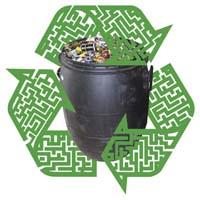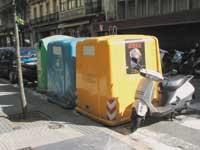Unforeseen secrets of recycling
2009/07/01 Lakar Iraizoz, Oihane - Elhuyar Zientzia Iturria: Elhuyar aldizkaria

We know they recycle batteries. They are of the kind that they are and have lasted what they have lasted. In principle it does not seem an activity of great mystery, since to recover the components of the batteries are subjected to different processes in recycling plants. But for us it has not been easy to gather the information necessary to count all the things we wanted to count on in this article.
Information about recycling can be found on several specialized websites. And it seems to be a quite transparent process. Like many other products that are recycled, they first have to separate the components from the batteries, since each one is recycled in their own way. To do this they pass through different crushing and separation sessions: crush, place in canaletas in vibration, clean with water, cryban, etc.
As you can see, they are purely mechanical processes, there are no secrets. In any case, it should be noted that special measures are sometimes required. In the case of lithium batteries, for example, they must take into account that they must be completely unloaded before opening the housings and removing the internal components. If charged, lithium ions can cause explosions.
Once separated, each component is properly treated. Each one has its particularities, but they do not seem to be kept secret. To separate powdered metals from batteries, for example, they are treated with acids and neutralized for the extraction of metal salts.
It can be more controversial what is done with the most polluting batteries, that is, how cadmium is recycled from cadmium nickel batteries. But don't think you have something special. For this purpose, the process called distillation is used, consisting of heating the remains of the crushed batteries up to 800-900 C for the cadmium to evaporate. Then the cadmium vapor passes through a tube that is cooled. In this way, cadmium is condensed, finally obtaining a cadmium with a purity of 99.95%.
On other occasions the pyrometallurgical method is used, which consists of the heating of the components up to about 1.450 C. At this temperature alloys of various metals (cobalt, nickel, iron and copper, among others) and inert slag are generated.
Finally, the materials obtained from these recycling processes are reusable in the industry, so a new life for batteries begins.
No one knows where anyone knows where
There seems to be nothing wrong with the process of recycling batteries, but it has been very difficult to name and surname these processes, that is, to know where they are made. In Europe only 40 companies recycle batteries and batteries, according to the European Association of Portable Batteries (EPBA). One of them is in Erandio: Recypilas. However, they only recycle button and prismatic batteries (salt and alkaline) in their facilities, they do not work with batteries.
Although they do not recycle, they collect all types of batteries and batteries, since one and the other are grouped in the selective collection of waste. Recypilas collects batteries and batteries from all over Spain from the hand of the entities responsible for selective collection. They differentiate the collected according to the chemical components that contain and adequately treat each subgroup.
Those who do not recycle them go to duly authorized final managers, companies that recycle them. The one who works with them is in France, as they tell us in Recypilas. But we have not wanted to give the name of the company. This is one of the mysteries. We have also known that in Spain there are no entities that recycle batteries.
However, many organizations that deal with selective collection of batteries and batteries want to hide this information. The Barcelona company Blipvert, a company specializing in recycling and selective collection, for example, says on its website that they recycle batteries in the same facilities. And they send them to the facilities of Pilagest. And they called us to Pilagest to tell us that they do not recycle batteries. The same happened in the Ecopilas Foundation of Madrid, founded for the integrated management of batteries and batteries, in which we were indicated that the batteries and batteries that were collected are sent to Recypilas and that are recycled in its entirety.
We know, however, that this information is not complete. But completing the information is not an easy challenge, as representatives of some and other companies begin to turn around when asked what are the last recipients of the batteries. Why? The truth is that we have not been able to find reasons to answer this question.

Gai honi buruzko eduki gehiago
Elhuyarrek garatutako teknologia






